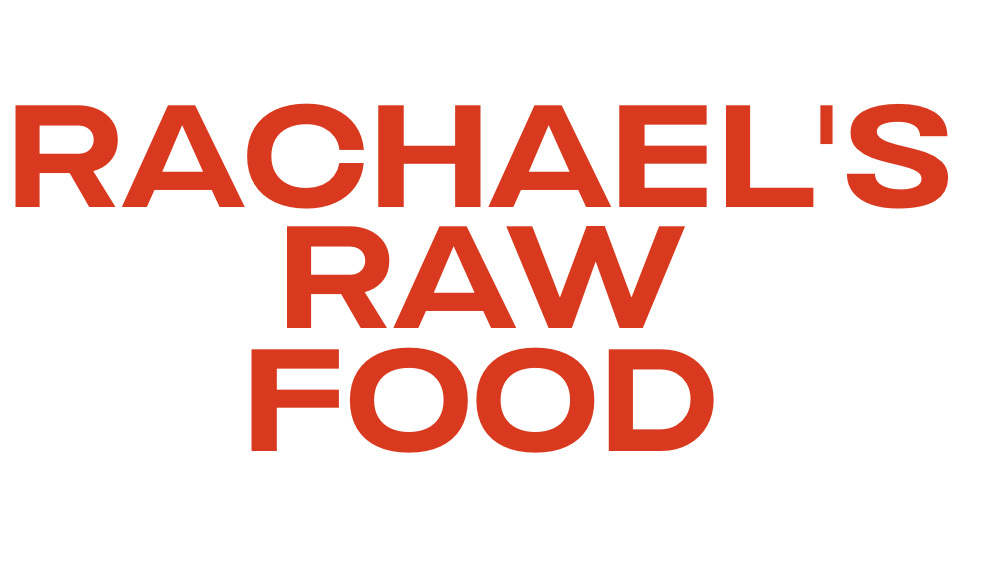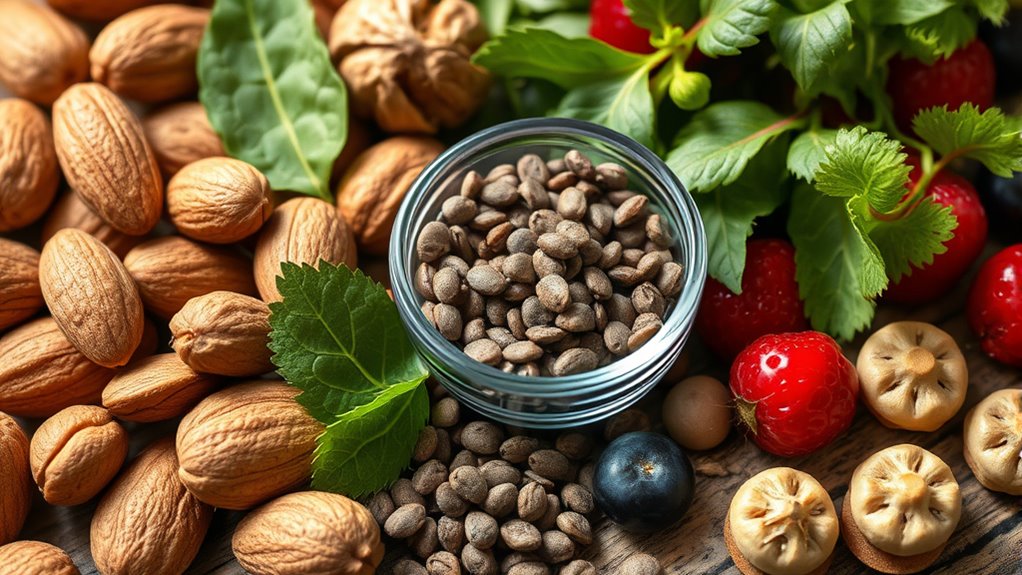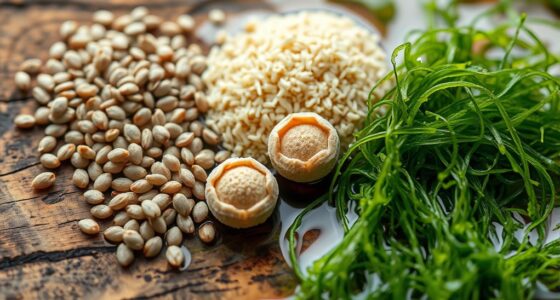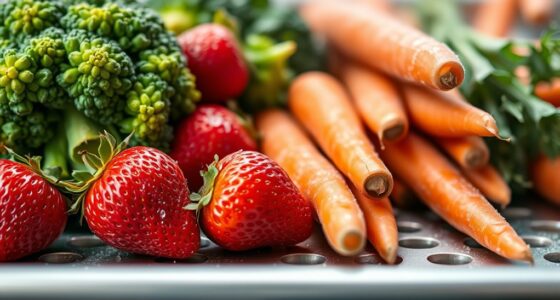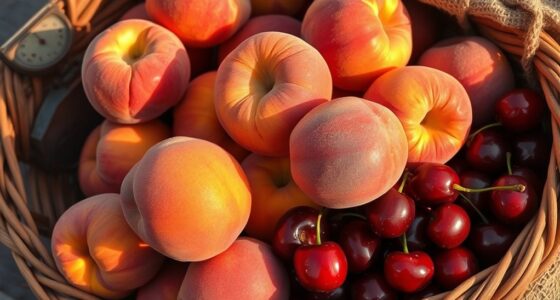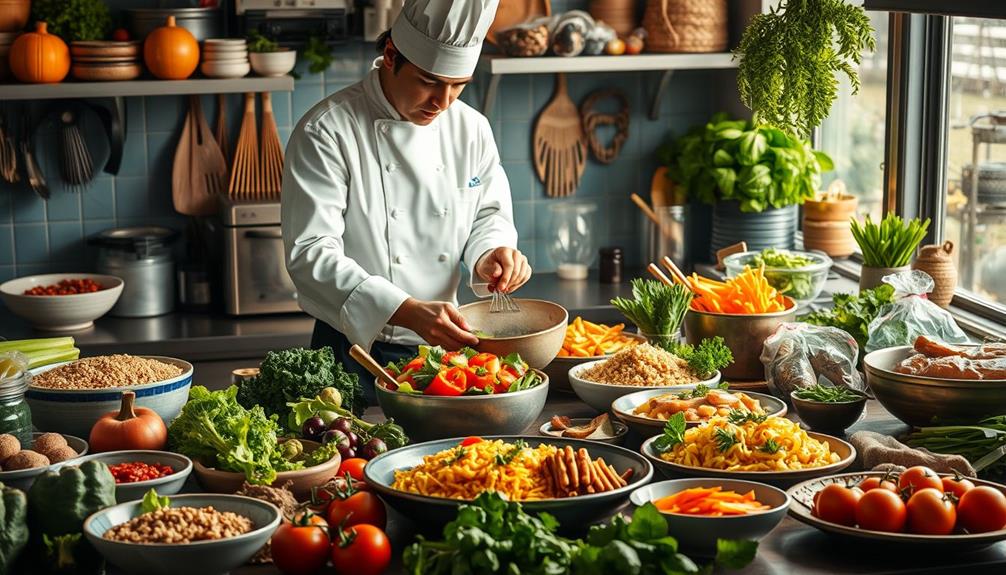Nuts and seeds pack a high calorie density, with about 160-200 and 150-170 calories per ounce, making them energy-dense options that can boost your healthy fat intake but need portion control. Fruits usually have 30-70 calories per 100 grams, offering volume and natural sweetness without many calories. Greens are very low in calories, often under 20 per 100 grams, supporting nutrient intake and satiety. Understanding these differences helps you balance your diet—if you keep exploring, you’ll uncover even more details.
Key Takeaways
- Nuts typically contain 160-200 calories per ounce, making them calorie-dense and nutrient-rich.
- Seeds generally offer 150-170 calories per ounce, providing healthy fats and concentrated energy.
- Fruits have a lower calorie density, around 30-70 calories per 100 grams, supporting volume with fewer calories.
- Greens are very low in calories, often less than 20 calories per 100 grams, ideal for nutrient-dense, low-calorie diets.
- Understanding calorie density helps balance intake of energy-dense nuts, seeds, and lighter fruits and greens for dietary goals.
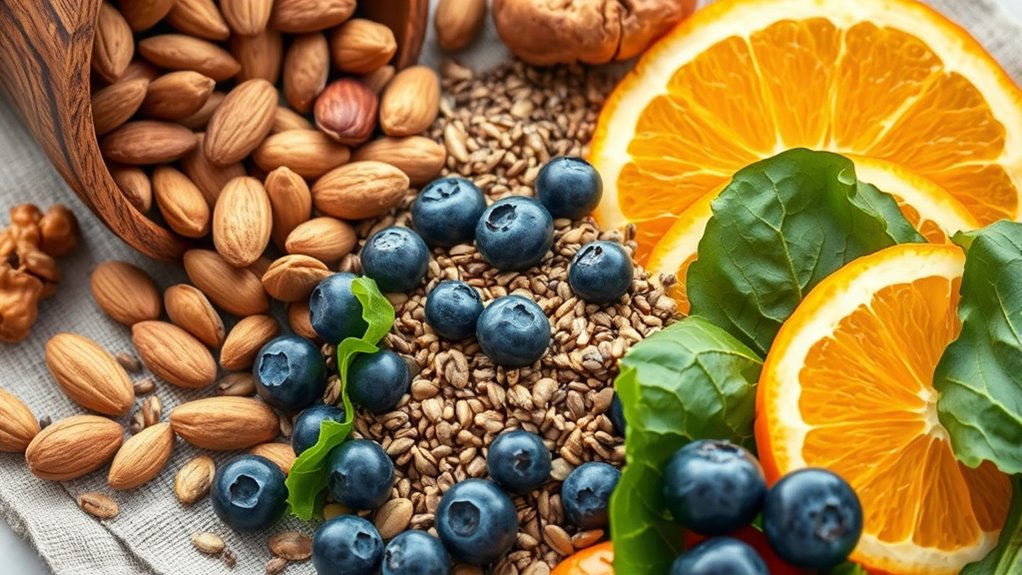
Understanding the calorie density of raw staples is essential for making informed dietary choices. When you’re choosing between nuts, seeds, fruits, and greens, knowing how their calorie content compares helps you plan balanced meals and manage your calorie intake effectively. For example, if you’re trying to boost your healthy fat intake, nuts might seem like the perfect snack. However, a nut calorie comparison reveals that while nuts are nutrient-dense, they are also high in calories—typically around 160-200 calories per ounce. This means you need to be mindful of portion sizes, especially if you’re watching your weight. Seeds, on the other hand, tend to have a slightly different profile. Their energy density can vary, but generally, seeds like sunflower or pumpkin seeds pack about 150-170 calories per ounce. Their seed energy density makes them a concentrated source of nutrients and fats, so they’re excellent for quick energy but still require moderation.
As you compare these staples, you’ll notice that seeds often provide a higher density of healthy fats and calories compared to many fruits and greens. Fruits, which are naturally lower in calorie density, typically range from 30-70 calories per 100 grams, making them a great option if you’re seeking volume and sweetness without excessive calories. Greens, like spinach or lettuce, are even lower—often less than 20 calories per 100 grams—allowing you to fill your plate with nutrient-rich, low-calorie foods that support satiety without overloading your calorie budget.
Understanding the differences in calorie density helps you make smarter choices based on your dietary goals. If you’re aiming for weight loss or calorie control, incorporating more greens and fruits can help you feel full while consuming fewer calories. Conversely, if you’re looking to gain weight or support high-energy needs, nuts and seeds provide dense calories packed with healthy fats, protein, and micronutrients. Keep in mind that while nuts and seeds are more calorie-dense, they also offer significant health benefits, so moderation is key. By paying attention to the calorie comparison and seed energy density, you can balance your intake and optimize your diet. Ultimately, knowing the calorie density of raw staples empowers you to choose foods that align with your health goals, whether that’s losing weight, maintaining energy, or simply eating more mindfully.
Frequently Asked Questions
How Does Cooking Affect the Calorie Density of Raw Staples?
Cooking usually increases the calorie density of raw staples because it breaks down cell walls, making nutrients and calories more accessible. Different cooking methods, like boiling or roasting, can concentrate calories or cause some nutrient loss, affecting overall calorie content. You should consider nutrient retention, as gentle methods preserve more nutrients, while high heat can reduce some calories slightly. So, cooking changes calorie density based on method and duration.
Which Raw Staples Are Best for Weight Loss?
Think of raw greens and berries as your weight loss allies—nature’s lightweight champions. They serve as snack alternatives that fill you up without packing extra calories. Incorporate leafy greens and fresh fruits into your meal planning to stay satisfied and energized. These staples are low in calorie density, making them perfect for shedding pounds while enjoying vibrant, wholesome flavors. Stay consistent, and you’ll see progress bloom like a garden in spring.
Are There Differences in Calorie Density Among Organic and Conventional Nuts?
You’ll find that organic and conventional nuts have similar calorie densities, so choosing organic doesn’t drastically change calorie intake. However, organic nuts often retain more nutrients due to fewer pesticides and better farming practices. This nutrient retention can make them a healthier option overall. Keep in mind, portion size still matters, whether organic or conventional, for maintaining your weight loss goals.
How Does Portion Size Impact Calorie Intake From Raw Staples?
Think of portion size like a traffic light—small, moderate, or large. When you practice portion control, you manage your calorie intake by moderating energy density. For example, a handful of nuts provides a satisfying crunch without overloading calories. Larger portions can quickly turn a healthy snack into excess energy intake. Staying mindful helps you enjoy raw staples without tipping the balance toward overeating or calorie overload.
Can Raw Staples Be Included in a Low-Carb Diet?
Yes, you can include raw staples like nuts, seeds, fruits, and greens in a low-carb diet, but with some caution. Nut inclusion offers healthy fats and fiber, making them good low-carb options if you choose in moderation. Focus on lower-carb fruits and greens, and limit high-carb nuts. Always track your portion sizes to stay within your carb limits and enjoy these staples as part of a balanced low-carb plan.
Conclusion
Now that you understand the calorie density of nuts, seeds, fruits, and greens, picture your plate as a vibrant mosaic of energy. Each choice adds a splash of flavor and significance, like brushstrokes on a canvas. By selecting these raw staples wisely, you fuel your body’s engine with the richness of nature’s bounty. Embrace this colorful palette, and watch your health blossom like a garden in full bloom.
